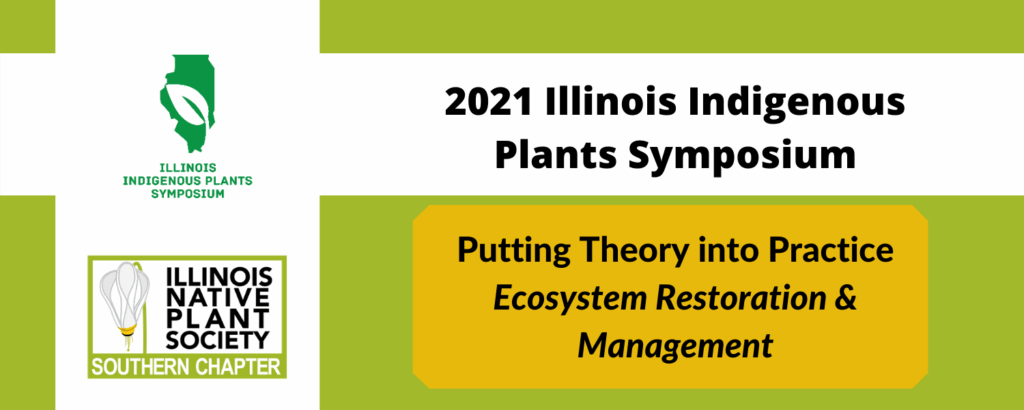2021 Illinois Indigenous Plants Symposium, April 15 – April 17

The 2021 Illinois Indigenous Plants Symposium will be held virtually from April 15 through April 17! Join us to explore this year’s theme, “Putting Theory into Practice: Ecosystem Restoration and Management.” Nine sessions held over three days provide numerous learning opportunities on topics ranging from different management techniques to successful management partnerships. Join us!
The symposium is being offered at no cost to you – but registering for a participant ticket is required to access the event in Hopin, the virtual event platform. In lieu of a registration fee, please consider donating to the Conservation Fund, a fund managed by the southern chapter of the Illinois Native Plant Society to support projects that promote the conservation, preservation, and study of native plants in southern Illinois.
SCHEDULE and REGISTER
2021 SYMPOSIUM SESSION DESCRIPTIONS
Vascular Flora and Rare Plants of the Illinois Audubon Society Round Pond Swamp Preserve, Pope County, Illinois
Paul Marcum
Round Pond Swamp Illinois Natural Areas Inventory site encompasses 526 acres in southern Pope County. Illinois Audubon Society has recently acquired 347 acres at the south end of the INAI. This purchase, along with 206 acres owned and protected by The Nature Conservancy, effectively protects the entirety of this important natural area. In 2019, botanists at the Illinois Natural History Survey were contracted to conduct a vascular plant inventory of the site, as well as assess the natural communities, rare plant species records, invasive species, and other management issues. During the course of the 2019 growing season, over 600 vascular plant species were recorded and four new Illinois state-listed plant species were documented for the site, bringing the total for Round Pond Swamp up to 10 Illinois endangered or threatened plant species. Also, one plant species not seen in Illinois for 160 years was rediscovered.
Forest Management Projects on the Shawnee
Justin Dodson
Forest management can be accomplished using a variety of silvicultural tools and mechanisms for implementation. The objectives you are trying to achieve will influence the tools that are used. We will look at a few projects across the Shawnee National Forest and the tools and mechanisms utilized to move them towards a desired condition.
Effects of Forest Windstorm Disturbance on Invasive Plants in Protected Areas of Southern Illinois, USA
Eric Larsen and Melissa Daniels
Southern Illinois has been affected by a number of severe windstorms over the last 20 years. We sought to investigate how blowdowns caused by these windstorms might contribute to the invadedness of forest parcels by non-native plants. We found that blowdowns were more invaded than statistically similar areas of undisturbed forests, but that invadedness decreased with increasing time since disturbance. Larger blowdowns were more invaded than smaller blowdowns and may recover more slowly. Our findings suggest land managers should prioritize treatment of invasive plants in larger and more recent blowdowns.
Bottomland and Floodplain Forest Restoration
Bruce Henry
This talk will explore bottomland and floodplain forest restoration in the Middle Mississippi River corridor. Specific management strategies being implemented within the Middle Mississippi River National Wildlife Refuge will be highlighted.
Growing Season Burns
Scott Crist
Description forthcoming
Emerald Ash Borer and its Impact on Southern Illinois High-Use Recreation Areas
Zach DeVillez
This talk will cover information about what emerald ash borer is, how it leads to widespread tree mortality, and what impact it will have on high-use recreation areas in southern Illinois. The talk will cover where we have found emerald ash borer in southern Illinois, the magnitude of infestation and tree damage we are observing, and what we can expect in the future.
Metapopulation and metacommunity structure in sandstone outcrop communities
David Barfknecht
Land fragmentation and other detrimental processes continue to remain a concern for both land managers and ecologists, and the few remaining natural grassland habitats remaining within southern Illinois have been diminished since pre-European settlement. Therefore, understanding how these discrete patches interact between each other by sharing populations and communities is crucial. This research describes which plant species exhibit metapopulation dynamics and the overall metacommunity structure in a group of sandstone outcrops in Pope County, Illinois.
A Partnership in Stewardship: The Nature Conservancy in Southern Illinois
Caleb Grantham & Nathan Speagle
The Nature Conservancy’s Southern Illinois Interagency Habitat and Fuels Crew (SIIHFC) has spent the past three and a half years practicing a holistic, landscape-level approach to land management. Through partnerships with the Shawnee National Forest, IDNR, private landowners and others, the SIIHFC has worked across legal boundaries to minimize the impacts of invasive plants, let the sun shine in our forests, and return fire to the landscape. Explore the history of the SIIHFC along with details of their timber stand improvement projects and fire management in the region.
Let the Sun Shine In: An Innovative Conservation Partnership
Mike Baltz
The Let the Sun Shine In conservation partnership helped to bring order and efficiency to the oak ecosystem recovery effort in southern Illinois. Partners coalesced around common objectives and (ultimately) a vision document; focused their efforts utilizing four innovative steps; and operate using a constellation collaboration approach that helps catalyze multi-partner projects maximize efficiency.
BIOGRAPHIES
Dr. Mike Baltzis the former southern Illinois Area Director for the Nature Conservancy and is currently the Let the Sun Shine In program coordinator. He has a Master’s degree in Environmental Science from Miami University and a PhD from the University of Missouri. His research area of expertise is migrant songbird ecology and conservation.
David Barfknecht is a doctoral student and researcher at the Gibson Plant Ecology Lab at SIU-Carbondale. David’s most recent work focuses on how natural xeric forest openings change overtime based on their community composition, and metapopulations and metacommunities, and spatial dynamics. His research largely focuses on community ecology, phylogenetics, biogeography, and biostatistics.
Scott Crist is the Fuels Specialist for the Shawnee National Forest. In this position, he is responsible for planning, implementing, and monitoring prescribed fires in a variety of terrain and fuel types across southern Illinois. He began his career in forestry in 1994 with a summer job with the City of Decatur Forestry Department, before working temporary positions in Idaho, Colorado, Wyoming, North Carolina, and Washington for the Forest Service, National Park Service, and US Fish and Wildlife Service. He served as a Fire Suppression Crew Foreman in New Mexico for three years before coming to the Shawnee, where he has been since 2003. His fire career has taken him to 25 states. He is qualified as a Division/Group Supervisor and Prescribed Fire Burn Boss Type 2. He serves as the Operations Section Chief for the Shawnee’s Type 3 Team and as an alternate Division Supervisor with the Eastern Area Type 2 Team. He also teaches a number of classes and is in the Advisory Board for the Oak Woodlands and Forests Fire Consortium.
Zach DeVillez is a forestry technician with University of Illinois Extension Forestry at the Dixon Springs Agricultural Center, where he spends most of his time on emerald ash borer research. From Harrisburg, Zach spent much of his time growing up in the Shawnee National Forest, which led him to pursue a career in forestry. He graduated from Southern Illinois University with a Bachelor’s degree in Forestry Natural Resource Management. Prior to his work with U of I, he spent a year working for a forestry consulting business working in forest stand improvements, invasive species management, and forest inventories. He currently serves as the program coordinator for the Illinois Forestry Association.
Justin Dodson is a Silviculturist for the Shawnee National Forest. He is in charge of managing forest health, stocking levels, growing space, how trees will be removed to improve conditions, and regeneration after harvest or natural disturbance. He has been in his current position for 5 years, but has been working for the Forest Service for almost 15 years – in the Shawnee for 9 years, and in the Chequamegon-Nicolet NF in Wisconsin for 6 years. He has worked in various other positions over that time such as trails technician, volunteer coordinator, reforestation technician, and stand exam forester. He has a Master’s degree in Human Dimensions of Forestry and a Bachelor’s degree in Forest Recreation and Resource Management, both from Southern Illinois University. He completed the National Advanced Silviculture Program (NASP) to become a nationally certified silviculturist in the Forest Service in 2016.
Caleb Grantham and Nathan Speagle are members of TNC’s Southern Illinois Interagency Habitat and Fuels Crew. All graduates of Southern Illinois University Carbondale, their time studying in southernmost Illinois fostered a deep passion for stewardship of the region’s unique diversity and beauty. Their efforts to protect and restore native ecosystems were recently awarded the USDA Forest Service Eastern Region 2019 Honor Award.
Bruce Henry is a regional forest ecologist for the US Fish and Wildlife Service. His current focus is on bottomland forest ecosystem restoration and management on big river floodplains in Illinois, Missouri, Iowa, Wisconsin, and Minnesota. Prior to his current position he worked as a natural history biologist restoring glades, fens, and sand prairies for the Missouri Department of Conservation. In previous years he was a member of The Nature Conservancy’s Southern Illinois Invasive Species Strike Team and a field biologist and burn crew member for the Nature Conservancy in the Texas Hill Country. He completed his undergraduate studies at the University of Illinois, and studied fire ecology in graduate school at SIU Carbondale School of Forestry. He resides along the Mississippi River in northeast Missouri with his wife and two children.
Eric R. Larson is an assistant professor in the Department of Natural Resources and Environmental Sciences at the University of Illinois, Urbana-Champaign. He works on the management and conservation of both invasive and imperiled species. Melissa K. Daniels led this research as a graduate student at the University of Illinois, and is currently employed in environmental consulting in Grand Junction, Colorado.
Paul Marcum is a life member of the Illinois Native Plant Society and has served on the state INPS board since 2008. He was INPS President from 2017-2018. Professionally, Paul is an Associate Scientist/Botanist with the Illinois Natural History Survey (INHS) Wetland Science Program, on campus at the University of Illinois – Urbana/Champaign. In this capacity he co-coordinates activities within the group and conducts environmental surveys for potential Illinois Department of Transportation projects.
Paul has been fortunate to research and publish more than 25 scientific manuscripts and over 600 technical reports on Illinois wetlands, natural areas, and rare plant species. He has served on the Illinois Endangered Species Protection Board’s (IESPB) Endangered Species Technical Advisory Committee (ESTAC) for plants for the past 10+ years. Paul is the administrator for a few Facebook plant groups including Midwest Graminoids. Paul lives in Champaign, Illinois, with his partner Jean Mengelkoch, a mammalogist at INHS. In his free time Paul looks for plants. Check out his photos on Instagram at paullovesplants.

